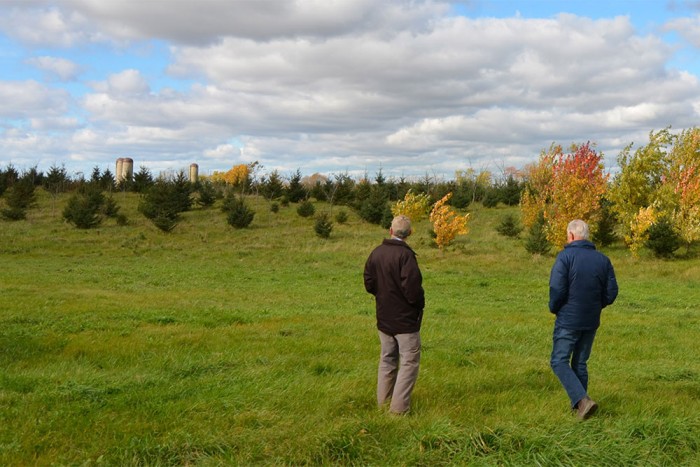Ausable Bayfield Conservation 75th Anniversary
Ausable Bayfield Conservation Authority (ABCA) has worked in partnership with community for 80 years
The Ausable Bayfield Conservation Authority has protected life and property, and worked in partnership with the community to protect and enhance water and soil and habitat, for almost 80 years.
In 2026, the 80th anniversary of this local, rural conservation authority will be celebrated.
The following is archived information from Ausable Bayfield Conservation's 75th anniversary in 2021:
Ausable Bayfield Conservation invited community to celebrate 75 years of local watershed management in 2021
Public invited to celebrate 75 years of conservation success as Ausable Bayfield Conservation Authority (ABCA) recognizes 75th anniversary
The year 2021 was a momentous year in local watershed conservation.
Ausable Bayfield Conservation Authority (ABCA) invited the public to help celebrate 75 years of conservation (1946-2021) in this watershed community.
This took place during the organization’s 75th anniversary year, in 2021.
The former Ausable River Conservation Authority was Ontario’s first conservation authority, created on July 30, 1946. The Bayfield River watershed and smaller streams were added in 1971.
We thank you for having helped us to celebrate 75 Years of Conservation all year long.
On July 30, 2021 we released this historical slide show video. We hope you enjoy it:
You helped us to celebrate 75 years of working in partnership with you to protect watershed resources, life and property, soil, water, and habitat for living things.
Watch the introductory video for the 75th anniversary year of Ausable Bayfield Conservation featuring Doug Cook, then Chair of the ABCA Board of Directors:
Here is the link to the video:
Read the Anniversary-Edition Annual Report
For the special 75th-anniversary edition of the Ausable Bayfield Conservation Annual Report (1946-2021), visit our Annual Reports page:
75th Anniversary Activities in 2021
Ausable Bayfield Conservation staff members, working with the public, hosted a number of activities in 2021 to celebrate the watershed community’s past conservation successes and also to leave a legacy for the future with new conservation initiatives.
“Local municipal leaders showed great vision when they called for the creation of this conservation authority back in 1946,” said Doug Cook, 2021 Chair of the ABCA Board of Directors. “We have completed important projects over the past 75 years to protect life and property, preserve watershed resources, and to improve water quality, soil health, forest and wetland conditions, and habitat for all living things,” he said. “This success has been possible thanks to the vision of local municipal leaders, the support of our local ratepayers, and an engaged community of donors and volunteers, along with many other community partners.”
The 75th anniversary committee adapted activities to ensure they reflected public health direction to help keep people safe during the current pandemic.
To receive news about Ausable Bayfield Conservation subscribe to the electronic newsletter here:
Municipal Partnership Profile Features
In this celebration of 75 years of Conservation we want to acknowledge the municipal-public-conservation partnerships in each of our 12 member municipalities.
We prepared and distributed media features about all 12 member municipalities in Ausable Bayfield watersheds.
All 12 articles are included (in abridged form) in our special 75th Anniversary Edition (2021) Annual Report:
Here is our feature on the Township of Lucan Biddulph:
Township of Lucan Biddulph

LUCAN BIDDULPH STEWARDSHIP SPANS DECADES – In the top two photos, we see the before and after planting photos at the Wetland Project and Nature Study Area, a Watershed Champions project, at Wilberforce Public School in Lucan. In the bottom photo, a tree planting crew plants trees in Lucan Biddulph. When the township has to remove a tree, they replace it with two.
Conservation remains strong focus in Township of Lucan Biddulph even as community grows
By Shevaun Verhoog, Aquatic Resource Technician, Ausable Bayfield Conservation Authority (ABCA)
The Township of Lucan Biddulph is not only the home of several tributary streams that contribute to the Little Ausable River but it is also the home of a growing number of residents. As development continues to boom in Lucan Biddulph, the municipality continues to foster its close relationship with Ausable Bayfield Conservation Authority (ABCA).
“We consider the ABCA partners in our growth,” said Ron Reymer, longtime Chief Administrative Officer (CAO) at the Township of Lucan Biddulph. “We all have an interest in making sure things get done correctly.”
Reymer has worked for the township for more than 30 years. He said that, in those three decades, he and the township have developed a close working relationship with the conservation authority and its staff. He said Ausable Bayfield Conservation and the township have similar philosophies of finding cooperative and partnership solutions. "We try to work with people, to sit down together and figure it out," he said.
Some of the most notable projects over his past 30 years working with ABCA include the two-zone flood mapping done in the 1990s. Other projects have included numerous tree planting projects that have taken place behind municipal buildings. Each year, the Township of Lucan Biddulph buys trees for the parks and roadsides tree replacement initiative. Two trees are provided for every tree removed under their roadside tree replacement program. “Every year we buy trees and every year, from storms or from age, some trees need to come down,” he said. “Our policy is that when we remove a tree we plant two trees.”
The council, staff, and ratepayers of Lucan Biddulph have made local conservation a priority.
The students of Wilberforce Public School, Lucan, showed they were Watershed Champions by doing a project at their school. To watch the video about the Wilberforce Wetland Project and Nature Study Area visit this link:
Ausable Bayfield Conservation’s Annual Reports, over the years, document many stewardship projects each year by participating landowners in Lucan Biddulph. There is great value to these projects, which combine the investments of participating property owners with those of funding partners. There are benefits in economic terms of project value and in terms of protecting the watershed resources upon which we rely. These actions protect water quality, soil health, and habitat for the native fish species of the Little Ausable River.
Some of Lucan Biddulph’s residents have been recognized as Conservationists of the Year. For instance, Paul and Vic Hodgins, owners of Shadyside Farms, were winners in 2005. The award winner the next year was the Middlesex Eco Crew, nominated by the Township of Lucan Biddulph. The Eco Crew helped Lucan Biddulph municipal staff remove four truckloads of illegally-disposed garbage from a steep riverbank on Fallon Drive, north of Lucan, over three days.
These are just some examples of Lucan Biddulph putting conservation into action. There are many more.
Ausable Bayfield Conservation is celebrating its 75th anniversary (1946-2021) in 2021. The conservation authority looks forward to continuing to protect and enhance watershed resources through a close and productive working relationship with all of its 12 member municipalities, including Lucan Biddulph’s council, staff, and residents.
– In 2021, Ausable Bayfield Conservation Authority (ABCA) is celebrating its 75th anniversary (1946-2021) and 75 Years of Conservation. ABCA is honouring its 12 member municipalities, during this anniversary year, for their partnership, over the past 75 years, which helps to protect life and property, water, soil, and habitat for all living things.
To learn more visit abca.ca and this web page:
#AusableBayfield75th
Municipality of Lambton Shores
Here is our feature on stewardship and other conservation projects in the Municipality of Lambton Shores:
Lambton’s ‘other’ shore: Celebrating the Ausable River and 75 years of conservation
By Ian Jean, Forestry and Land Stewardship Specialist, Ausable Bayfield Conservation Authority (ABCA)
The Municipality of Lambton Shores is blessed with fantastic natural features such as Lake Huron beaches and sand dunes; and Carolinian forest and deep, fertile soils. With big Lake Huron forming the western border, it’s easy to overlook the Ausable River, which forms the eastern municipal boundary. One of the most species-rich river systems in Canada, the Ausable supports more than 80 different fish; 26 species of freshwater mussels; and 21 reptile species.
Entering the municipality at Rock Glen near Arkona, the Ausable flows north through the Ausable River Valley, a provincially recognized Area of Natural and Scientific Interest (ANSI) along the river between Rock Glen and Thedford. The steep-sided valley is home to Carolinian forests with trees such as Flowering Dogwood; Sassafras; and Tulip Tree reaching their northern limit here. At the bottom of the valley, the river’s sand and gravel riffles support rare freshwater mussels such as the Snuffbox; Northern Riffleshell; Wavy-rayed Lampmussel; and the Purple Wartyback.
While the river’s waters today are directed west to the lake at Port Franks through ‘The Cut,’ before 1875, the river continued north to Grand Bend, and the municipal boundary follows the original riverbed. At Grand Bend, the Ausable made a hairpin turn south and paralleled the lake to its mouth at Port Franks. There was no river outlet at Grand Bend, and it was the hairpin turn in the river that was responsible for the name ‘Grand Bend.’
In 1892, the Grand Bend Harbour was cut through to the lake, cutting off 14 kilometres (km) of river bed to the south. Today, the spring-fed Old Ausable Channel (OAC) provides habitat to a number of rare fish. The mouth of the Ausable River at Port Franks is also a place of great biodiversity. The main river; Mud Creek; and several small spring-fed inland lakes, wetlands and intervening dunes support a variety of birds, mammals and reptiles. The Port Franks area is home to Ontario’s only lizard (the Five-lined Skink) and was the last place in Canada where the extirpated Karner Blue Butterfly was seen.
The Ausable Bayfield Conservation Authority, established in 1946 (at that time the Ausable River Conservation Authority), has been fortunate to work collaboratively with community and municipal partners on a number of important conservation projects. These projects, and the ongoing work of residents and community groups, are important for the viability and function of the river the important natural habitats it supports.
A key project in the early years of the Conservation Authority was to support the creation of Pinery Provincial Park, which opened in 1959. Prior to that time, the land was owned by the Canada Company, with various private development projects being considered. Ausable River Conservation Authority (as it was known at that time), was part of a group that lobbied the Province of Ontario to purchase the land. Initially unsuccessful, the Conservation Authority then produced the ‘Pinery Report’ which it presented to service clubs, interest groups and organizations in order to build public support for a provincial park. The efforts of these local groups and the Conservation Authority paid off, with the provincial decision to purchase the Pinery lands in 1957.
Rock Glen Conservation Area is another example of community collaboration to support conservation and highlight also some of the unique natural history of Lambton Shores. Park development surrounding the waterfall and river area was initiated in 1948 by the Arkona Lions Club. Picnic tables, swings and barbecues were donated by the Lions Club and placed in a park area above the Rock Glen Falls waterfall. In 1954 the former Ausable River Conservation Authority purchased the nine-acre park area, which has expanded to 60 acres since that time. In 1985, Arkona Lions Museum and Information Centre was moved to Rock Glen, where it continues to showcase fossils and cultural artifacts from the Lambton Shores region. The Lions continue to operate the museum (which is currently being renovated) which, along with the waterfall, picnic grounds and hiking trails, draw tens of thousands of visitors annually.
More recently, conservation efforts have focused on stewardship projects to protect and improve water quality. The health of the river, and the lake, depend on our collective efforts to keep soil and contaminants out of our streams. A drive along any of the rural roads in the municipality and you will notice where people are taking positive actions such as tree-lined streams; field windbreaks; and water control berms. These stewardship projects on our farms and other lands help reduce surface water runoff, reducing soil erosion and downstream flooding, sedimentation and erosion of streams. By keeping topsoil in fields, these projects also improve soil health and agricultural productivity, a true win-win.
Lambton Shores is fortunate to have many active volunteer groups engaged in conservation projects. The Lambton Shores Phragmites Community Group has made significant progress in managing invasive Phragmites grass which threatens boating and significant wildlife habitat. Similarly, Lambton Shores Nature Trails is involved in development and maintenance of more than 20 km of hiking trails with trail maps, interpretive signage and projects such as installation of a floating dock and stairs for canoes and kayaks at Ausable Cut Conservation Area. The Lakeshore Eco Network, through fundraising and educational events, supports tree planting, climate action and conservation in the region.
These are just a few examples to illustrate the hard work and dedication of community volunteers that supports the health of our community and its natural areas. As we celebrate 75 years at Ausable Bayfield Conservation Authority, we look forward to continuing this important work in partnership with the community.
– In 2021, Ausable Bayfield Conservation Authority (ABCA) is celebrating its 75th anniversary (1946-2021) and 75 Years of Conservation. ABCA is honouring its 12 member municipalities, during this anniversary year, for their partnership, over the past 75 years, which helps to protect life and property, water, soil, and habitat for all living things. To learn more visit abca.ca and this web page:
#AusableBayfield75th
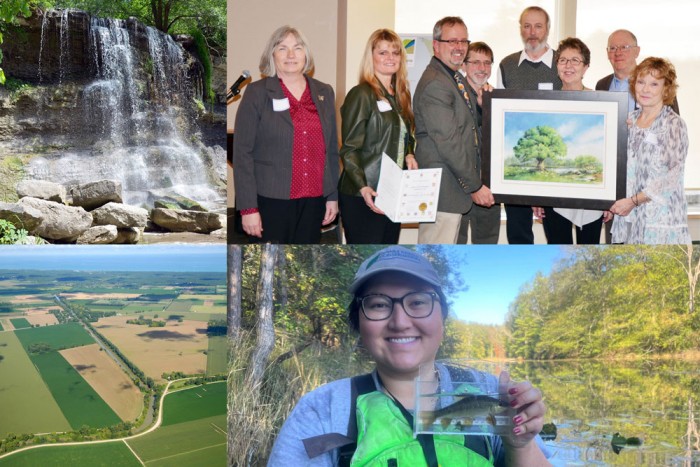
PHOTO INFORMATION: LAMBTON SHORES COMMUNITY WORKING TO IMPROVE WATERSHED – In this photo collage, of four photos, we see (clockwise from top left) scenic Rock Glen Falls at Rock Glen Conservation Area (RGCA) in Arkona; members of the Lambton Shores Phragmites Community Group – 2016 winners of the Conservationist of the Year Award – making strides against ‘Canada’s worst invasive plant,’; Rosalind Chang, Healthy Watersheds Technician with Ausable Bayfield Conservation holding a Lake Chubsucker fish at the Old Ausable Channel (OAC) in Pinery Provincial Park in Municipality of Lambton Shores; and an aerial view photo of the start of the Ausable River Cut. The photo with Lambton Shores Phragmites Community Group (LSPCG) shows, from left to right in photo, Kate Monk, of Ausable Bayfield Conservation Authority (ABCA); Michelle Hay; Brian Horner, General Manager and Secretary-Treasurer, ABCA; Ray Horban; Derek Scott; Nette Pachlarz; Paul Petersen; and Nancy Vidler, LSPCG Chair. Absent from photo is Bill MacDonald.
Municipality of Bluewater
Here is our feature article, profiling conservation projects in the Municipality of Bluewater, posted on November 30, 2021:
Park association has worked for decades maintaining Pioneer Park in Bayfield in the Municipality of Bluewater
Landowners, residents, and volunteers in Municipality of Bluewater help to maintain beautiful parks, trails, and nature areas
By Meghan Tydd-Hrynyk, Planning and Regulations Officer, Ausable Bayfield Conservation Authority (ABCA)
When we think of the Municipality of Bluewater we think of three historic villages (Bayfield, Hensall, and Zurich) and destinations for culinary and shopping and cultural experiences. We think of five beautiful Lake Huron beaches and we think of countryside and we think of schools. We think of trails and nature areas including Bannockburn Conservation Area. We also think of all the landowners and residents and volunteers who devote countless hours towards creation of a healthy watershed community.
There is so much we could share about this vibrant community if we had the time. Since we only have so much space in this article, I would like to focus today on a very special place in Bluewater – Pioneer Park. (This is a very special place cared for by a very special group of people, the Pioneer Park Association.)
Pioneer Park is a privately owned park. It is located on the shoreline of Lake Huron in the scenic Village of Bayfield in Ontario, Canada. In 1945 local resident Lucy Woods, with the assistance of Jessie Metcalfe and John Stewart, organized the purchase of the land for a park. The land was incorporated and named Pioneer Park after an application for a charter was granted by the Government of Ontario in 1947.
The mission and purpose of the Pioneer Park Association is to promote the health and enjoyment of the Village of Bayfield and vicinity through owning, preserving, improving and managing a park or parks open to the public without charge and to undertake other projects for the welfare of the community.
In order for residents and vacationers alike to access the beach and maintain the parkland at the top of the slope, it was decided to complete shoreline protection work at the base of the slope along Pioneer Park Association property. In 1984, the Association contacted Ausable Bayfield Conservation Authority (ABCA) to install large 4-5 foot diameter concrete storm sewer pipes which would be placed along the toe of the bank and filled with sand/gravel. This method was employed and can still be seen along the beachfront in certain locations today.
In 2011, a project was undertaken in cooperation with ABCA and the Municipality of Bluewater. A geotechnical investigation was completed for the top of the bank near Bayfield Terrace. A coastal engineer was employed to design 100 feet of Pioneer Park’s shoreline protection project. A permit was issued by ABCA in January 2012. The work was completed in May 2012.
In 2018 more work was required along the shoreline of Lake Huron. Due to the high waters, the bank was sustaining ongoing erosion. A collaborative project between the Municipality of Bluewater, Pioneer Park and a neighbouring property owner was undertaken to help slow down the erosion process. A geotechnical engineer was employed to drill two boreholes. The project was designed by a Coastal Engineer for all three properties. Subsequently, three permits were issued to each party in November 2018.
A species-at-risk investigation was undertaken on the lake bluff at Pioneer Park by ABCA staff in September 2018 to ensure that any disturbance to the bank during construction was not going to have a negative impact on the environment. The work was completed in May 2019.
A large storm on November 1, 2020 caused more erosion and slumps to the bank of Pioneer Park.
Pioneer Park was issued a minor works permit from ABCA to address the further erosion. Detailed drawings were developed by Pioneer Park Association. The slumps that developed from the November 1, 2020 storm could not be fixed at this time because the equipment couldn’t reach the top of the slump areas. Both ABCA and the Ontario Ministry of Natural Resources and Forestry have given Pioneer Park extensions to fix the bank slumps. The work is scheduled to be completed before the end of 2021 with specialized equipment that will reach the site while maintaining minimal damage to the slope and beach area.
The ongoing collaborative approach with multiple landowners and agencies has allowed Pioneer Park to realize its mission statement. Looking at the tranquil park, people may not know all the dedication and hours that have gone into maintaining this space.
Pioneer Park is one notable example of residents in the Municipality of Bluewater working to the benefit of their community. There are many others. For instance, in 2020, Blue Bayfield won Ausable Bayfield Conservation’s Conservationist of the Year Award:
In Spring of 2020, the Huron-Perth Boomers magazine published an article, by Ben Forrest, about the work of the Huron Tract Land Trust Conservancy (HTLTC). The article described how the Bayfield River Valley Trail Association (BRVTA), along with many generous community donors, raised more than $70,000 to acquire the Bayfield River Flats and to donate it to the land trust for permanent preservation as a nature area.
To read the article visit:
- Huron-Perth Boomers (Spring 2020 issue)
Ausable Bayfield Conservation’s Healthy Watersheds and Forestry and Stewardship staff have worked closely with the Bluewater community on tree planting and stewardship projects and on rain barrel sales and rain garden establishment, a Stormwater Stroll (PDF file), and much more.
The Main Bayfield and Bayfield North communities have created and implemented community watershed plans to protect and improve water quality, forest and wetland conditions, and soil health.
The Fred A. and Barbara M. Erb Family Foundation, a foundation dedicated to advancing an environmentally healthy and culturally vibrant metropolitan Detroit and a flourishing Great Lakes ecosystem, has generously invested considerable resources to support Great Lakes stewardship in Bayfield and area.
Volunteers from Bluewater Shoreline Residents’ Association (BSRA) have had an integral role, for about 15 years, helping ABCA staff with water sampling and monitoring of Escherichia coli (E. coli) at beaches along Lake Huron. The dedication of these and other citizen scientists from Bluewater helps provide valuable data, to numerous agencies, about our local water quality. We simply could not run the program without their help.
Those are all articles for another day! Today we would like to congratulate the Pioneer Park Association on three quarters of a century of stewardship of Pioneer Park. We would also like to thank all the residents, landowners, and volunteers in the Municipality of Bluewater for many decades of partnership on conservation projects that help to create a healthy watershed community.
– In 2021, Ausable Bayfield Conservation Authority (ABCA) is celebrating its 75th anniversary (1946-2021) and 75 Years of Conservation. ABCA is honouring its 12 member municipalities, during this anniversary year, for their partnership, over the past 75 years, which helps to protect life and property, water, soil, and habitat for all living things. To learn more visit abca.ca and this web page:
#AusableBayfield75th
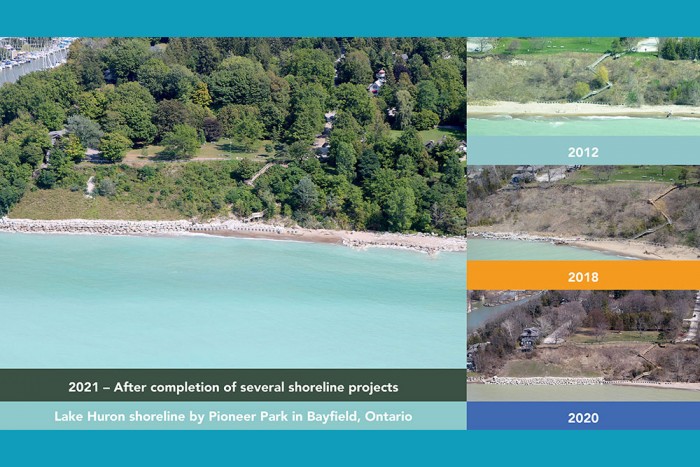
PHOTO COLLAGE: This collage of four photos includes a main photo (at left) showing the toe of the Lake Huron bluff, near Pioneer Park in Bayfield, in 2021, after the completion of several shoreline projects over the years. The other three photos show this same stretch of Lake Huron, in the Municipality of Bluewater, in previous years (2012; 2018; and 2020).
Township of Warwick:
Here is our feature, posted on November 19, 2021, about the Township of Warwick:
Stewardship in Warwick Township has positive downstream benefits for Rock Glen Falls, Ausable River, species at risk
Residents in Township of Warwick planting trees, properly disposing of household hazardous waste, enhancing wetlands, protecting water and soil
By Abbie Gutteridge, Chair, Ausable Bayfield Conservation 75th Anniversary Planning Committee
Rock Glen Falls, located at Rock Glen Conservation Area in Arkona, Ontario, has always been an attraction to hikers, nature lovers and photographers. Rock Glen Falls feeds into the Ausable River, an important river system that provides habitat to several species at risk. Many people do not consider the origin of the Rock Glen Falls, however. Where does that water come from? The Hobbs-McKenzie Drain, along with several smaller drains, directly feed Rock Glen Falls. A portion of the drainage area lies north of Townsend Line but most of the watershed drainage area is located in the Township of Warwick.
The positive stewardship actions taken in this watershed directly protect the quality of water at Rock Glen Falls. This positive work also protects species at risk found in the Lower Ausable River. Those species at risk include the Snuffbox; Northern Riffleshell; and Mapleleaf mussels.
In total, a little more than 17 square kilometres of Warwick Township fall into the Ausable Bayfield Conservation Authority (ABCA) watershed, while the majority contributes to the Bear Creek Headwaters; Brown Creek; as well as the Plympton Shoreline and Lambton Shores Tributaries in the St. Clair Region watershed.
Art Eastman lives and farms in Warwick Township. He is one of the landowners who does what he can to protect soil and water. For years, Mr. Eastman has planted trees and windbreaks on his property. “This is a windy area, so the main reason we plant the trees is to protect against wind erosion,” he said. He also noted it was good for wildlife in the area. In addition, he has established wetlands on his property.
Positive actions throughout the Township of Warwick include tree planting projects, streambank stabilization, and establishing and enhancing wetlands. All of these individual actions add up to benefits for water quality downstream.
The Township of Warwick is also proactive in making sure there are opportunities for residents to dispose of large waste items and electronics. In October, the township hosted its Annual Fall Cleanup, which allows township residents to take their large waste items and electronics to several depots, free of charge. By providing an easy way to dispose of these large items and electronics it protects creeks and rivers because it reduces the chance they might end up disposed improperly. Making it easy for residents to properly dispose of these items goes a long way towards keeping our watershed clean.
We have been lucky to work in close partnership with the residents of the Township of Warwick for 75 years and we look forward to many more years of protecting our water, soil, and habitat together.
– In 2021, Ausable Bayfield Conservation Authority (ABCA) is celebrating its 75th anniversary (1946-2021) and 75 Years of Conservation. ABCA is honouring its 12 member municipalities, during this anniversary year, for their partnership, over the past 75 years, which helps to protect life and property, water, soil, and habitat for all living things.
To learn more visit abca.ca and this web page:
- Ausable Bayfield Conservation 75th Anniversary #AusableBayfield75th
STEWARDSHIP IN THE TOWNSHIP OF WARWICK HAS POSITIVE DOWNSTREAM BENEFITS – This photo collage shows tree planting and stewardship and water quality monitoring. Residents of the Township of Warwick have been practising stewardship over many decades. These positive actions help to protect downstream water quality and species in the Ausable River.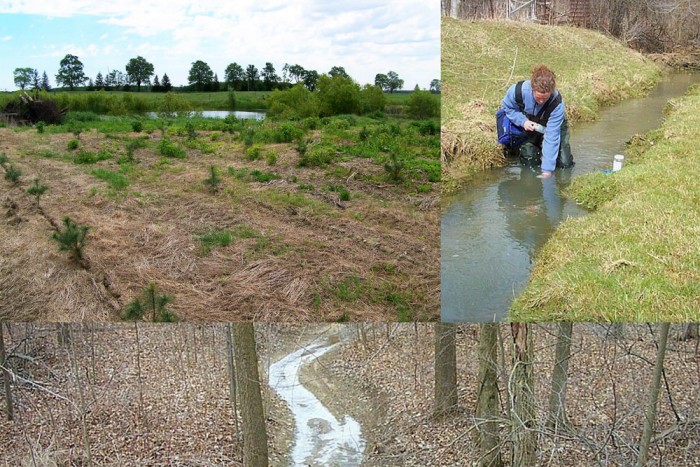
Township of Adelaide Metcalfe:
Here is our feature, posted on November 3, 2021, about the Township of Adelaide Metcalfe:
In it for the long run . . .
75 years of Conservation – Township of Adelaide Metcalfe
By Kate Monk, Projects Coordinator, Ausable Bayfield Conservation Authority (ABCA)
Conservation is not new to Adelaide Metcalfe. The Township of Adelaide was a founding member of the former Ausable River Conservation Authority, established in 1946 through a partnership between local municipalities and the Province of Ontario. The township has had a representative, a voice and a vote at the boardroom table ever since. As such, it is part of a 75-year effort to conserve water and soil and shows commitment from councils, staff and landowners.
Sixty-six square kilometres (16,308 acres) in Adelaide Metcalfe township drain into Adelaide Creek. The headwaters are near Highway 402 and enter the Ausable River north of Keyser in North Middlesex. From there, the Ausable River flows through the Ausable Gorge, Ausable River Cut and eventually reaches Lake Huron at Port Franks. The municipality is also in the Sydenham River watershed which is part of the St. Clair Region Conservation Authority.
Several landowners have worked with Ausable Bayfield Conservation Authority (ABCA) staff to complete on-the-ground projects such as tree planting, wetland creation and erosion control that conserve soil and water in the community and downstream. David Ball, of Ball Farms, is one of those landowners.
David has been doing conservation projects on his farms for 30 years. He was a Conservationist of the Year Award winner in 1992 after he completed a project to fence cattle out of the watercourse and provide alternate watering. Since then he has planted trees on several farms and along creeks. These trees have many benefits including protecting the creek banks, holding onto soil, and providing shade which lowers water temperatures for aquatic life. In the days when there was cattle at Ball Farms they did fencing and planting projects to reduce erosion. Erosion from wind and runoff is always an issue so “trees help to keep the soil in place.”
David is one of many landowners in the Township of Adelaide Metcalfe who are planting trees and practising land stewardship to protect soil health and water quality. David says he’s not the only one planting trees – his neighbours are also working with the conservation authority to plant trees for the future.
Ball Farms is located near Kerwood, Ontario. David is the third generation of his family to farm at the family farm. “I have been here all my life as was my father before me and his father before him,” he said. He is a self-described tree lover and bird lover who has worked with Ausable Bayfield Conservation to plant about 40 acres of trees. “Over the years I’ve planted a number of trees,” he said. When visited at his farm by ABCA Forestry and Land Stewardship Specialist Ian Jean, David jokes that “I try to keep Ian busy.” About 10 per cent of David’s property is in trees. He has planted trees in areas where it’s not practical to farm. “I’m putting the trees back where it’s not practical to use the big machinery of today,” he said.
David likes the wildlife that shows up after he has planted trees, like deer and many kinds of birds (including meadowlarks, red-winged blackbirds, finches, orioles, turkeys, woodcocks, and hawks.) As trees grow, “species show up we didn’t have before,” he said. David enjoys Carolinian tree species and he also enjoys the changing of colours in autumn when deciduous trees drop their leaves. People enjoy watching the trees grow over the years, he said.
We thank David for his efforts and we thank all the landowners making stewardship improvements in the Township of Adelaide Metcalfe. In the past 10 years, four landowners have restored 9.4 acres of wetlands and enhanced or retired an additional 9.6 acres of wet area surrounding the wetlands in Adelaide Metcalfe. In addition, 500 trees were planted around one of the wetland sites. These projects consist of excavations and berms to hold back water in flood plain areas.
The wetland projects help to provide water storage on the landscape during storm events reducing flooding and erosion downstream. They allow sediments and nutrients to settle out in the wetland and provide filtration, reducing the sediments and nutrients that end up in the rivers or Lake Huron.
Landowners have been doing good work beyond their partnership with the two conservation authorities.
Everyone has a role to play in protecting water for current and future generations and we thank them for their efforts.
– In 2021, Ausable Bayfield Conservation Authority (ABCA) is celebrating its 75th anniversary (1946-2021) and 75 Years of Conservation. ABCA is honouring its 12 member municipalities, during this anniversary year, for their partnership, over the past 75 years, which helps to protect life and property, water, soil, and habitat for all living things.
To learn more visit abca.ca and this web page:
Municipality of Central Huron:
Here is our feature, posted on October 13, 2021, about the Municipality of Central Huron:
‘Experience our Nature’ in Central Huron
By Mari Veliz, Healthy Watersheds Manager, Ausable Bayfield Conservation
‘Experience our Nature!’ is the invitation on the 2021 Central Huron Fall Guide. With an abundance of natural areas including the Lake Huron shoreline, watercourses, valley lands, wetlands, woodlots, Areas of Natural and Scientific Interest (ANSIs), and other environmentally sensitive areas, Central Huron has recognized its natural potential.
Watersheds in Central Huron are recognized as some of the more natural areas in the Ausable Bayfield Conservation Authority (ABCA) watershed area. In 2021, ABCA is celebrating its 75th anniversary (1946-2021) and would like to acknowledge the contributions the residents and the Municipality of Central Huron have made to balance the interests of development and natural protection. The shoreline watersheds and the Bayfield River watershed joined the ABCA area in 1972. Over the years since then, there has been a ‘willingness to try something new’ to provide the basis for community, building a strong economic foundation including a vibrant agricultural sector, with a focus on protecting and enhancing watershed resources.
From a watershed perspective, small, jump-able temporary streams or swales account for 90 per cent of a river’s flow. How we manage these systems helps us better manage flooding, erosion and water quality in downstream rivers and lakes. Municipal staff at Central Huron, the late Tom Sinclair and Geoff King in particular, have demonstrated innovative approaches in the management of these ‘headwater’ systems. Responding to community concerns about water quality, Tom Sinclair helped to divert excess water from the Town of Clinton through a settling pond at the edge of Clinton.
The Municipal Drainage Superintendent of Central Huron, Geoff King, has helped to construct projects that help to meet ecosystem needs and improve agricultural production. The off-line sediment control pond on the Steenstra Drain, near the corner of Parr Line and the Bayfield Road, is one example. Mr. King also helped with projects in the Gully Creek study.
Mayor of Central Huron, Jim Ginn, has sat on the ABCA Board of Directors (2004 – 2012 and 2018) and served as the Chair of our Board (2010-2011). He promoted watershed actions that protect fish in Middlesex Centre; Bluewater; Huron East (with the Huronview Demonstration Farm); and (naturally!) Central Huron.
Since 2008, 30 landowners in Gully Creek, a shoreline tributary north of Bayfield, have employed many agricultural best management practices (BMPs) and supported the field and watershed monitoring. Best management practices have included reduced tillage, implementation of cover crops, nutrient management and the installation of 45(!) Water and Sediment Control Basins (WASCoBs or berms). The evaluation of Gully Creek has helped to develop a broader awareness, provincially, around the importance of cover crops, improved soil health, and a ‘stacked’ approach to agricultural BMP implementation.
In context of the broad community support to recognize nature in Central Huron, recent land donations to the Huron Tract Land Trust Conservancy, including the Woodburne Farm and Mayhew Tract properties, demonstrate the deep commitment by members of the community. These donations mean that natural areas in the Municipality of Central Huron will be protected and experienced for generations to come.
– In 2021, Ausable Bayfield Conservation Authority (ABCA) is celebrating its 75th anniversary (1946-2021) and 75 Years of Conservation. ABCA is honouring its 12 member municipalities, during this #AusableBayfield75th anniversary year, for their partnership, over the past 75 years, which helps to protect life and property, watershed resources, water, soil, and habitat for all living things.
To learn more visit abca.ca and this web page:
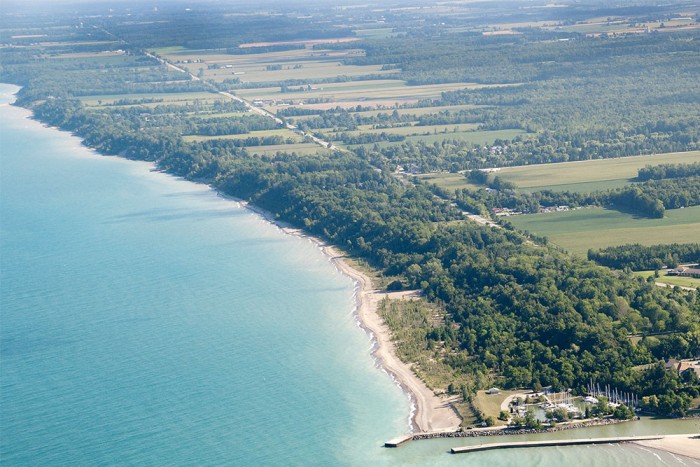
Here is information on the photo:
AERIAL PHOTO SHOWS PARTS OF MUNICIPALITY OF CENTRAL HURON, NORTH OF BAYFIELD AREA: This photo shows Bayfield (in the Municipality of Bluewater); and north of that area, parts of the Municipality of Central Huron along the Lake Huron shoreline. Awareness is being increased, across Ontario, by implementation and study of best management practices (BMPs) by dozens of landowners in Gully Creek, a shoreline tributary north of Bayfield and within the Municipality of Central Huron. Agricultural producers in Central Huron have planted cover crops, reduced tillage, and installed 45 berms or Water and Sediment Control Basins (WASCoBs). This approach of using multiple integrated BMPs helps to build soil health and protect water quality. (File photo by Daniel Holm)
Township of Perth South:
Here is our feature, posted on October 5, 2021, about the Township of Perth South:
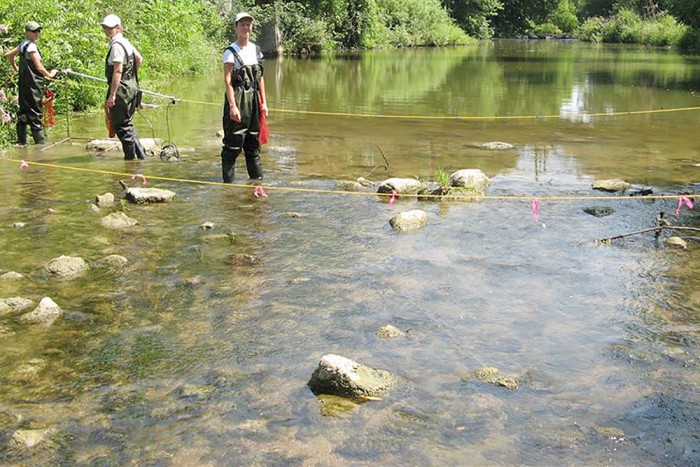
In this photo, Ausable Bayfield Conservation staff members monitor mussel populations in the Little Ausable River, downstream of the Township of Perth South. Stewardship projects by participating landowners in the Township of Perth South help to reduce runoff and protect aquatic species at risk.
Perth South plays important role in Ausable River headwaters
Stewardship work in Perth South helps to protect mussels downstream
By Shevaun Verhoog, Aquatic Resource Technician, Ausable Bayfield Conservation
While most of the Township of Perth South drains toward Lake Erie, and only a small portion of the township is located in the Ausable Bayfield watershed (draining towards Lake Huron), the area is an important one as it contributes to the headwaters of the Ausable River.
Tributary streams along Highway 23, between Woodham and Whalen Corners, form the headwaters of the Little Ausable River. The Little Ausable runs through the Township of Lucan Biddulph before joining and becoming the Ausable River. This river eventually reaches Port Franks where it drains into Lake Huron. These streams are starting points for the lives of many animals. Some of these aquatic creatures are classified as species at risk, due to a decline in their populations.
Species found in the area include freshwater mussels. Freshwater mussels spend most of their life buried in the streambed. Freshwater mussels are similar to clams. They are known as bivalves. This means they are two shells attached on a hinge.
Mussels filter through water for their food and, as a result, they can act as indicators for water quality based on changes in their populations. In the Ausable River we find 26 different species of freshwater mussels. Six of those species are considered species at risk. These include the Kidneyshell; Snuffbox; Northern Riffleshell; Wavy-rayed Lampmussel; Rainbow Mussel; and Mapleleaf Mussel. These animals prefer clean, cool, and flowing water as their habitat, and can live for many years. They are vulnerable to changes in water quality, such as an increase of pollution or siltation. Decreases in the water quality can result in a decline in the freshwater mussel populations, as they are unable to survive significant changes to their natural habitat.
Stewardship projects within Perth South, and other municipalities within the watershed, have helped decrease runoff of soil, pollutants and sediment. Field windbreaks, tree lines, vegetative buffer strips, and berms all help slow the flow of water running off into the streams. This helps maintain critical habitat for these species at risk. Projects like these can have impacts on the streams adjacent to where they are but can also influence the lives of species living all along the Ausable River.
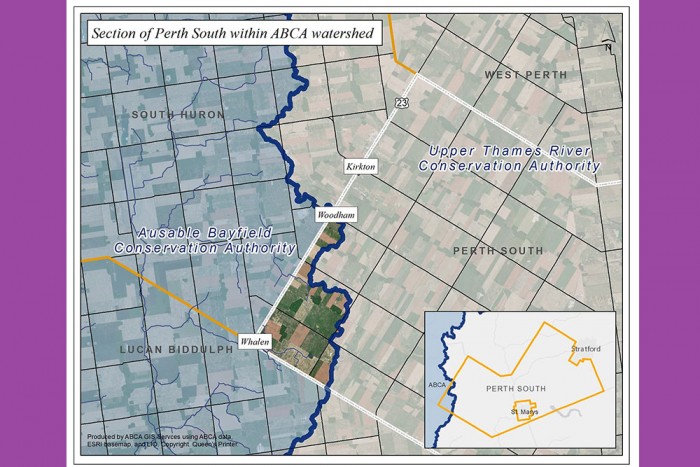
Ausable Bayfield Conservation Authority celebrates its 75th anniversary (1946-2021) this year and we want to recognize projects and partnerships since 1946 in our 12 member municipalities. Today we thank the Township of Perth South, and participating landowners, for their decades of stewardship and partnership. We look forward to continuing biomonitoring research and stewardship projects in Perth South and our other watershed municipalities, over the next 75 years!
– In 2021, Ausable Bayfield Conservation Authority (ABCA) is celebrating its 75th anniversary (1946-2021) and 75 Years of Conservation. ABCA is honouring its 12 member municipalities, during this anniversary year, for their partnership, over the past 75 years, which helps to protect life and property, water, soil, and habitat for all living things. To learn more visit our #AusableBayfield75th Anniversary web page:
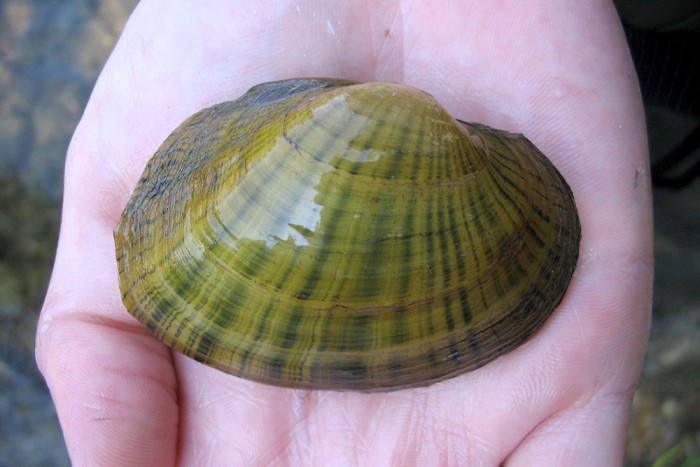
PHOTO ABOVE:
The Wavy-rayed Lampmussel is a local freshwater mussel species at risk. Positive stewardship actions by landowners and residents in the Township of Perth South help to protect this and other species.
Municipality of North Middlesex:
Here is our feature on North Middlesex:
North Middlesex home to climate change station, Parkhill Dam and conservation area
Celebrating 75 Years of Conservation in Municipality of North Middlesex
By Tommy Kokas, Water Resources Engineer, Ausable Bayfield Conservation Authority
This year, 2021, we celebrate 75 Years of Conservation during the 75th anniversary (1946-2021) of Ausable Bayfield Conservation Authority (ABCA). During this special commemorative year we are sharing profiles of community partnerships in our 12 member municipalities. Today’s feature is Municipality of North Middlesex.
Partnerships
A rich legacy of stewardship; flood forecasting, warning and prevention; conservation area enjoyment; local monitoring; and leading-edge provincial research has taken place in the Municipality of North Middlesex during the past three quarters of a century. That legacy is possible only because of the productive partnership with the municipality and the landowners and residents of North Middlesex.
We would like to thank the Municipality of North Middlesex, and the people of the municipality, for a partnership over many decades that has protected agricultural land from flooding; that has created a nature destination in Parkhill Conservation Area and Parkhill Reservoir and Scenic Lookout and Boat Launch; and that has created improvements through local stewardship projects. There are many positive things we could highlight about North Middlesex but in this municipal feature series we’re going to focus on two main parts of the story:
- Part One: Parkhill Dam, Parkhill Reservoir, and Parkhill Conservation Area
- Part Two: Parkhill Integrated Water and Climate Research Station
The Parkhill area is home to the Parkhill Creek Integrated Water and Climate Research Station, one of Ontario’s most comprehensive stations for monitoring weather and climate change impacts. The Municipality of North Middlesex is also home to Parkhill Conservation Area, Parkhill Dam, and Parkhill Reservoir. Parkhill Dam was created, in part, to protect agricultural land from flooding and that makes it distinct in Ontario.
We hope you enjoy reading about these important features in the Municipality of North Middlesex and I would like to thank you again for all you do for conservation in this watershed. We look forward to many more years of partnership together.
– In 2021, Ausable Bayfield Conservation Authority (ABCA) is celebrating its 75th anniversary (1946-2021) and 75 Years of Conservation. ABCA is honouring its 12 member municipalities, during this anniversary year, for their partnership, over the past 75 years, which helps to protect life and property, water, soil, and habitat for all living things.
To learn more visit abca.ca and this web page:

Municipality of Middlesex Centre:
Here is our feature on Middlesex Centre:
Landowners in Middlesex Centre have long history of taking positive stewardship actions in local watershed
Tributary streams contribute surface water, groundwater to system
By Ian Jean, Forestry and Land Stewardship Specialist, Ausable Bayfield Conservation Authority
The rolling fields and productive farmland of the Municipality of Middlesex Centre supply water to three of southern Ontario’s major watersheds: the Ausable, Thames, and Sydenham. The Ausable River itself does not flow through Middlesex Centre but several tributary streams contribute surface and groundwater to the system. These tributaries support important fish habitat and spawning areas within these streams and downstream in the main Ausable and, eventually, Lake Huron.
Farm owners and residents of Middlesex Centre have a long history of land stewardship and conservation work. For the past 75 years, Ausable Bayfield Conservation has been fortunate to be able to work with the community to help with conservation projects for the benefit of its residents and the broader watershed. During the last two decades alone, Middlesex Centre landowners have partnered with Ausable Bayfield Conservation to complete more than 50 conservation projects.
If you drive along any of the rural roads you will see the results of these efforts: tree-lined streams, field windbreaks, and wetlands. Less visible but equally important are in-field grassed waterways and erosion control berms. These stewardship projects are very important for controlling surface water flow, reducing soil erosion and flooding, and reducing sedimentation of streams. By keeping topsoil in fields, this infrastructure also improves soil health and agricultural productivity. That’s a true win-win.
Community leadership has been central to conservation. Local residents and farmer volunteers involved in the Middlesex Stewardship Council helped to support Ausable Bayfield Conservation efforts and projects in the area for many years. More recently, Trees for Lobo Township, a project started and run by community volunteers and now adopted by the Lions Club of Poplar Hill, provides trees for roadside planting in Middlesex Centre. During the past nine years, this initiative has seen more than 2,200 trees planted along roadsides in the township.
Nairn Creek is the largest tributary stream in the Ausable portion of Middlesex Centre. Fed by groundwater springs at its headwaters near Denfield, where it is also known there as Denfield Creek, the water runs south to Lobo Township, then turns northwest to join the Ausable at Nairn. Nairn Creek is significant in that it provides coldwater habitat for Brook Trout. This fish species has particular water quality requirements such as constant water flow, cold water temperatures, high oxygen concentrations, low suspended-solid concentrations, and streambeds free of silt. The presence of Brook Trout is a testament to local conservation efforts, and highlights the importance of ongoing stewardship and care to ensure the viability of the trout.
Funding support, from local, provincial and federal programs is available to local landowners for many conservation projects. One of the key roles of Ausable Bayfield Conservation is providing technical advice and assistance in securing financial support for these beneficial projects. As we celebrate 75 years at Ausable Bayfield Conservation Authority, we look forward to continuing this important work in partnership with the community.
– In 2021, Ausable Bayfield Conservation Authority (ABCA) is celebrating its 75th anniversary (1946-2021) and 75 Years of Conservation. ABCA is honouring its 12 member municipalities, during this anniversary year, for their partnership, over the past 75 years, which helps to protect life and property, water, soil, and habitat for all living things.
To learn more visit abca.ca and this web page:
#AusableBayfield75th

Municipality of South Huron:
This was our third municipal feature article, of the series, released on July 23, 2021:
Featured Municipality – South Huron
South Huron’s stewards, volunteers, communities make positive difference in Ausable Bayfield watersheds
Communities and volunteers have created and improved trails in South Huron and landowners have used innovative conservation methods to protect soil, water
By Abbie Gutteridge, Chair, Ausable Bayfield Conservation 75th Anniversary Committee
The Municipality of South Huron has a variety of landscapes – from acres of farmland, to forested trails, to urban centres and lakeshore communities. This diverse area has been shaped by the people who call it home.
The Ausable Bayfield Conservation Authority (ABCA) Administration Centre office has been located in South Huron for 75 years, first in Exeter, and then at the Morrison Dam Conservation Area east of Exeter since 1983. During this time, ABCA has had the privilege of working closely with the communities in South Huron on projects that benefit the entire municipality and the greater watershed.
Staff from ABCA have enjoyed working with many farmers on stewardship efforts throughout the municipality. Farms in Usborne and Stephen were among the early adopters of no-till and conservation tillage practices, with support from conservation programs. Always innovators, today many South Huron farmers have added cover crops to their rotation to improve soil health and productivity and help water quality. This not only benefits the crops, but also helps to reduce erosion and sediment in local streams, rivers, and Lake Huron.
When visiting MacNaughton Park in Exeter, Ontario you will find the start of the MacNaughton-Morrison Section of the South Huron Trail. This eight-kilometre trail follows the Ausable River and circles Morrison Reservoir, making it a scenic hike with diverse wildlife.
The MacNaughton-Morrison section of the Trail was constructed in 2002 as a partnership between several organizations in the community including: Ausable Bayfield Conservation Authority; Ausable Bayfield Conservation Foundation; Exeter Lions Club; the Municipality of South Huron; local landowners; and many other community supporters.
In 2018, Jones Bridge (dedicated by Donna Jones, in loving memory of Ted Jones) was built to connect the sections of the trail and allow walkers a safe way to cross the Ausable River. This bridge was made possible by generous donors and volunteers and is a testament to the spirit of community in South Huron!
The Friends of the South Huron Trail, formed in 2005, is a group of local volunteers who care for the trail and community by hosting cleanup days and events, fundraise for the trail and provide support that increases opportunities for people with limited mobility to experience nature on the trail. This group continues to help make this trail a benefit to the health and well-being of the South Huron community.
These are just a few examples of positive partnerships that have developed over 75 years, and we look forward to the next 25 years of working with the communities of the Municipality of South Huron!
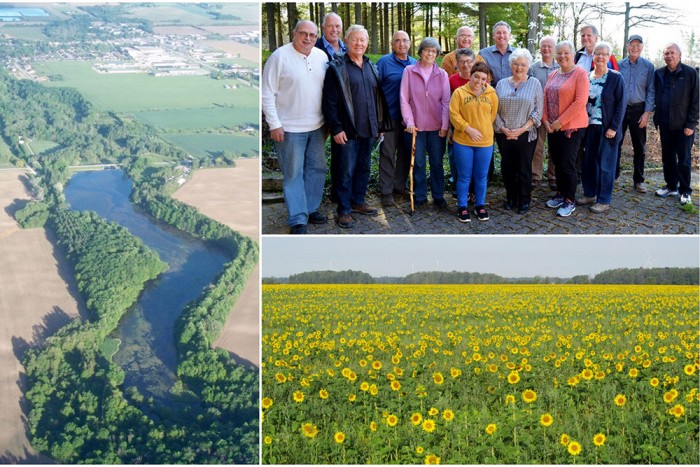
MUNICIPAL PROFILE SERIES FEATURES SOUTH HURON: During 2021, the 75th anniversary year for Ausable Bayfield Conservation Authority (ABCA), we are doing regular profiles of some conservation work in the communities of each of ABCA’s 12 member municipalities. Today’s featured municipality is the Municipality of South Huron. In this collage of three photos, we see (clockwise from left); tree planting and stewardship in South Huron; a file photo of some members of Friends of the South Huron Trail; and some beautiful sunflower cover crops planted to help improve soil health and water quality. Congratulations to the citizens and community groups of South Huron for your contribution to 75 Years of Conservation.
– In 2021, Ausable Bayfield Conservation Authority (ABCA) is celebrating its 75th anniversary (1946-2021) and 75 Years of Conservation in partnership with the community. ABCA is honouring its 12 member municipalities, during this anniversary year, for their partnership, over the past 75 years, which helps to protect life and property, water, soil, and habitat for all living things. To learn more visit abca.ca
Municipality of West Perth:
This was our second municipal feature of the series, released on June 21, 2021:
Featured Municipality – West Perth
Off to a good start
by Kate Monk, Manager of Stewardship, Land and Education at Ausable Bayfield Conservation
You wouldn’t know, looking at the tiny creeks in West Perth, that they will become the Ausable River that reaches Lake Huron at Port Franks, or the Bayfield River at Bayfield. The people who rely on the river, throughout its journey to the lake, owe a large measure of thanks to the landowners who work diligently to conserve the headwaters.
A drive through Hibbert Township and Logan Township shows the landscape features that help the rivers get off to a good start.
One of the most striking features are the tall, long rows of Spruce and Cedar trees.
Most of these trees were purchased from the Ausable Bayfield Conservation Authority (ABCA) Reforestation Assistance Program. Some landowners planted the trees but many hired ABCA to do the planting.
For decades, landowners have been planting tree windbreaks to prevent the wind from eroding valuable topsoil.
Many of the windbreaks stretch the entire length of a farm and are more than fifty feet tall. With lower wind velocity, the soil stays on the fields where it’s needed to grow crops. Windbreaks reduce wind speeds for up to 20 times their height. Although many windbreaks are perpendicular to roads, many have been planted along roadsides. These living snow fences can reduce the amount of snow blowing across roads, thereby improving driver visibility. They also provide habitat for beneficial bird species that will eat crop pests.
Windbreaks, planted along creeks and rivers, have the added benefit of shading the water, keeping it cool for fish and other aquatic life, and keeping soil from entering the creeks. Even grassed buffers can trap soil before it reaches the creek. These grassed buffers are often used by farm equipment to avoid compacting the farm fields and farm families enjoy walking along the creeks. The corridors of green provide excellent wildlife habitat.
Windbreaks that surround farmsteads are called shelterbelts. They help reduce heating costs and cooling costs while providing a more pleasant environment for livestock and farmers.
Hibbert is known for the back-forty forests; the long, linear woodlots in the middle of concessions. These include seeps and springs that feed the headwater streams. The snow stays in these woodlots a little longer in the spring to extend the spring freshet and augments base flow. Rain falling in woodlots also recharges aquifers. As an added bonus, the Sugar Maple woodlots produce maple syrup which supplements farm income.
It’s not just trees that help the rivers get off to a good start. Farmers are practicing crop rotation, conservation tillage, planting cover crops and installing berms and grassed waterways to keep the soil on the fields and build soil health, making it more resilient to drought and heavy rainfall events. Every one per cent of organic matter in the soil can absorb an inch of rain.
Thanks to the landowners in the Ausable and Bayfield headwaters for their dedication to conservation!

Photo collage information:
HEADWATERS STEWARDSHIP IN WEST PERTH HELPS AUSABLE, BAYFIELD RIVERS GET OFF TO A GOOD START – Ausable Bayfield Conservation Authority (ABCA) is celebrating 75 Years of Conservation in 2021, ABCA’s 75th anniversary year (1946-2021). During this special commemorative year, Ausable Bayfield Conservation is celebrating community partnerships and partnerships with its twelve member municipalities. Today’s featured municipality is the Municipality of West Perth. In this photo collage of seven photos, we see (clockwise from top left): 1. The Staffa sign in the headwaters of the Ausable and Bayfield Rivers; 2. A forest in the ‘Back 40’; 3. A buffer in West Perth; 4. A West Perth windbreak; 5. Conservation tillage in West Perth; 6. A West Perth forest; and 7. A shelterbelt in West Perth.
Tiny creeks in West Perth turn into the Ausable River reaching Lake Huron at Port Franks and into the Bayfield River at Bayfield. Therefore, Ausable Bayfield Conservation is thanking all the landowners using best management practices and stewardship to conserve the headwaters. Tall, long rows of Spruce and Cedar trees are among the features that help give the rivers a good start. Tree windbreaks and ‘living snow fences’ in West Perth help to preserve valuable topsoil from wind erosion. Grassed buffers trap soil before the creek. Forests in the ‘back 40’ include seeps and springs that feed headwater streams. Trees, conservation tillage, cover crops, berms, and grassed waterways all help to build soil health which helps in times of drought and times of heavy storms. Ausable Bayfield Conservation is thanking West Perth landowners for helping to give the rivers and lake a great head start.
(Photos by Kate Monk)
– In 2021, Ausable Bayfield Conservation Authority (ABCA) is celebrating its 75th anniversary (1946-2021) and 75 Years of Conservation. ABCA is honouring its 12 member municipalities, during this anniversary year, for their partnership, over the past 75 years, which helps to protect life and property, water, soil, and habitat for all living things. To learn more visit abca.ca
Municipality of Huron East:
This was our first municipal feature of the series, release on June 18, 2021:
Featured Municipality – Huron East:
The Municipality of Huron East, located in the headwaters of the Bayfield River
by Denise Iszczuk, Conservation Educator, Ausable Bayfield Conservation
Over the years, the Municipality of Huron East has supported and partnered with Ausable Bayfield Conservation Authority (ABCA) to educate local students about soil, water and habitat for all living things.
The staff and students of St. James and St. Columban Catholic Schools and Seaforth Public School have always been keen to learn about the world around them.
A favourite field trip is to study science at one of ABCA’s conservation areas and even making the trip to Rock Glen Conservation Area near Arkona.
Many students in Grade 6 were immersed in outdoor studies while attending the Sylvan Conservation Program at Camp Sylvan.
In 2011, students and staff at Seaforth Public School ‘greened’ up their school by planting trees and shrubs.
In recent years, the Municipality of Huron East participated in the Yellow Fish Road™ program of Trout Unlimited Canada for the painting of yellow fish by the storm drains. The yellow fish serve as a reminder that storm drains are linked to nearby rivers. Teachers and their students from Seaforth Public School were happy to get involved with this project.
This past autumn, local support helped to produce a Virtual Tour of the Water Treatment Facility in Seaforth.
This engaging video can be viewed on Ausable Bayfield Conservation’s YouTube Channel.
Hats off to Huron East!
The collage below, of four photos, shows Huron East students planting; water treatment operator Alyssa Keller in a video at the Seaforth water treatment plant; a school planting project; and Yellow Fish Road™ educational painting by storm sewer in Seaforth:

– In 2021, Ausable Bayfield Conservation Authority (ABCA) is celebrating its 75th anniversary (1946-2021) and is honouring its 12 member municipalities for 75 years of conservation to protect life and property, water, soil, and habitat for all living things. To learn more visit abca.ca
Ausable Bayfield Conservation invites public to enjoy 75th anniversary pop quiz
Ausable Bayfield Conservation Authority creates history and knowledge questions, trivia and survey for public during ABCA 75th anniversary
Ausable Bayfield Conservation Authority (ABCA) continues to create public information materials during the celebration of its 75th anniversary year in 2021.
The conservation authority created a new video, an introduction to 75 years of local watershed management (1946-2021), featuring Doug Cook, Chair of the ABCA Board of Directors. The video was released in April and it can be viewed on the 75th anniversary web page at abca.ca and on the Ausable Bayfield YouTube channel:
Staff members have also created trivia questions and answers to test your knowledge of conservation in the watershed. This pop quiz is to be shared on social media platforms in the coming weeks. Also, local people holding trivia activities can contact ABCA at 519-235-2610 or toll-free 1-888-286-2610 for questions and answers they can incorporate into their contests.
Ausable Bayfield Conservation has also created a public survey. Staff say the 14-question survey is a chance to test your knowledge (and learn about) local watershed management and also to provide your input into local watershed programs and services. You are invited to take the survey at this link:
- Take the survey now (Thank you for all the surveys which were submitted! Your input is helping us to improve our programs and services).
Abbie Gutteridge is Chair of Ausable Bayfield Conservation’s 75th Anniversary Planning Committee. She said the survey is a chance for ABCA to learn from local residents and for local residents to learn about conservation.
The trivia questions are a fun way to learn about some of the work that has taken place over the past 75 years, she said.
“I hope the video, trivia and survey – along with other activities over the course of the year – will engage people in learning more about the work that is happening, in partnership with the community, to protect life and property, water and soil, and habitat for all living things,” she said.
The former Ausable River Conservation Authority was Ontario’s first conservation authority, created on July 30, 1946. The Bayfield River watershed and smaller streams were added in 1972.
